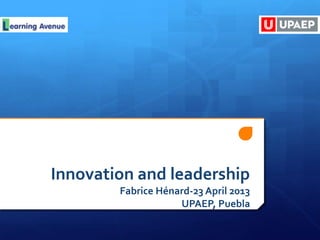Puebla2013 henard
- 1. Innovation and leadership Fabrice HÃĐnard-23 April 2013 UPAEP, Puebla
- 2. ï The context calls for more innovation ï What have been the impacts of these evolutions on Higher Education? ï Has leadership proved to be impactful? ï ï ï ï
- 3. 11/23/08 ï Expansion of the knowledge economy and growing middle class in many developing nations = higher demand for tertiary education. ï Global massification of education, not yet saturated, ï The traditional ageâgroup for higher education is also broadening: a. The demand from mature students for higher education is growing in many parts of the world. b. A lasting trend for some time. The knowledge economy has come
- 4. 11/23/08 ï The world of Knowledge Economy is changing in itself : a. HE has become an aspiration for all, b. Science is increasingly global and increasingly perceived as linked to human, social and economic progress c. Changes in the constituencies for knowledge (e.g. risk governance is a new fieldâĶ) The Knowledge economy is changing itself
- 5. 11/23/08 ï The 2008 financial crisis and the subsequent public debt crisis had many negative impacts especially on a. Business innovation and R&D b. Employment rate : Unemployment of highly skilled has increased Quarterly unemployment rate for high-skilled workers for selected countries ï Yet, the crisis and the recovery have been uneven across industriesâĶ and certain countries have better resisted the crisis than others: China, Korea Business funded R&D, yearly growth rate remains high The crisis has changed the settings of the knowledge economy
- 6. ï Overall, in response, governments introduced short- term measures and longer-term reforms, a large bunch of them focusing on HE with: a. High priority and increased resources allocated to Higher Education b. Increased budgets for higher education and universities (India, Poland, Sweden, Switzerland, etc.) c. Development of HE capabilities including infrastructures (Canada,Colombia, France, India, etc.) d. Maintained or increased hiring of researchers at university during economic downturn (Italy) e. Changes in the governance of HEIs : Reform of HEIs management and funding: confirmed trend in many countries towards greater autonomy and more competitive grant funding (away from âblockâ funding) â introduction of performance- and indicator-based allocation mechanismsâĒ Strengthen evaluation of uni/programmes In response, Govts introduced recovering measures associated with HE reforms 1/2
- 7. In response, Govts introduced recovering measures associated with HE reforms 2/2 ï Strengthen education for innovationâĶ ï Improve the teaching of STEM ï New teaching methods: increased hours of instruction (Germany, Ireland, Norway), new curricula, standards (Australia, Ireland, UK), ï New assessment practices (Austria, Norway, Poland) ï Teacher trainingâĶ ï Improving the teaching of entrepreneurship: ï Accelerate knowledge transfer to industry and society, ï Improving the conditions of technology transfer, ï Professionalisation, ï Raise awareness of IPRs in the research community (courses) and the general public ABOVE ALL, CALLING FOR INSTITUTIONAL RESPONSIVENESS!
- 8. What have been the impacts of such changes for Higher Education? Strengthen leadership at all levels
- 9. Has leadership proved to be impactful? ï Addressing the needs for social and economic development ï Opting for an outward orientation ï Fostering institution-wide-change ï Better decision-making ï Overcoming obstacles ï Systematic monitoring
- 10. ï ï ï ï Innovation as a driver for change ï How can leadership help? ï Innovation for quality ï How to foster leadership for quality?
- 11. ï Innovation leads to change a. R&D b. Employers/students c. International mobility d. Equity and drop out ï Innovation calls for experimentation a. AlternativeT&L practices b. Dissemination c. Sustaining ï Innovation includes risks a. Constant change b. Avant-garde frightens people Innovation as a driver for change
- 12. How? ï EncourageTeachers and students to be innovators ï Be a learning organisation ï Embed innovation in a wider range of policies How can leadership help? Conditions: ï Tailored to management ï Challenge thinking and modus operandi ï Embedded in the whole institution ï Strategically developped
- 13. ï An internal organisation in place ï Anyone should be a change agent ï Centralised vs. collegial ï Managing â improving quality Innovation for quality Leadership
- 14. ï Map distribution of responsibilities ï Create a leadership-friendly environment ï Establish appropriate organisational structures How to foster innovation for quality?
- 15. www.learningavenue.frfhenard @learningavenue.fr ï Evaluation ï Capacity Building ï Quality Expertise















